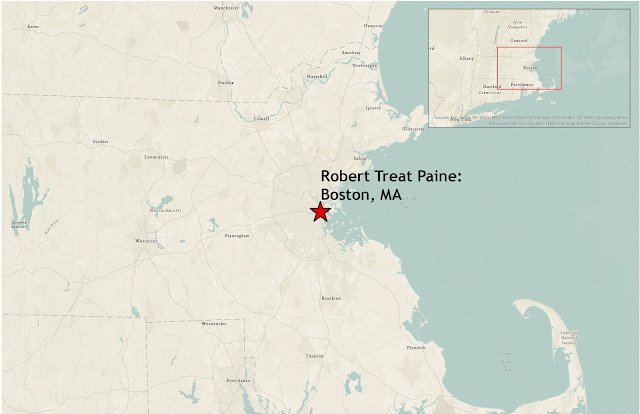Founding Fathers - Robert Treat Paine
Robert Treat Paine
Born: March 11, 1731 (Boston, Massachusetts)
Died: May 11, 1814 (Boston, Massachusetts)
This week we return to studying patriots born on the west side of the Atlantic to find out a little more about one of the Massachusetts signers. Born as the second-youngest of five children, Robert Treat Paine was the son of a Baptist minister named Thomas Paine and his wife, Eunice. His family tree was fairly notable, descending from a merchant named Stephen Hopkins who had initially come to the New World in 1610, then returned to England before crossing the Atlantic once more as the only passenger aboard the Mayflower with experience in the colonies. The young boy took his name from his maternal great-grandfather, Robert Treat, who had been the governor of Connecticut as well as founder of Newark, New Jersey. Another ancestor, Samuel Willard, had pastored Boston's Old South Church as well as served as vice president of Harvard College. Before Robert was old enough to start school his father was no longer a full-time minister, choosing instead to become a merchant, although he did continue to preach periodically. Young Robert was educated at the Boston Latin School before enrolling at Harvard, where the previous three generations of his family had graduated, at the age of 14. He graduated in 1749 right as his father's mercantile business fell apart, and attempted a number of vocational pursuits including teaching, merchant sailing, and whaling, but while he got to see many parts of the world he did not find monetary success.
Returning to Massachusetts in 1755, Robert Treat Paine began studying law with his mother's cousin, Judge Samuel Willard, and followed him into military service during the French and Indian War as a regimental chaplain during a campaign into New York. Two years later he was admitted to the bar, but once again his own personal achievement was coupled with bad news as his father died the same month. Despite his own frail health, Paine continued to work hard in order to start and build his legal practice, and rode a circuit throughout Massachusetts and modern-day Maine. In 1761 he moved to Taunton, MA, where he stayed for 20 years while rapidly developing his social standing. Paine soon secured his first public service position when he was named justice of the peace in 1763. After four years of courting, he married Sally Cobb in 1770 and the couple would eventually have eight children together, all the while maintaining an unusually spirited relationship that was evident in playful letters written any time they were separated. Later that same year, Paine's fateful moment came when he was asked to assist in the prosecution of the British troops involved in the Boston Massacre, arguing against his old rival and future fellow signer, John Adams. The defense was successful in having most of the charges dropped or reduced, but Paine successfully established his own credentials as a powerful legal mind who stood on the side of liberty for the colonists. Four years later, he was elected to a seat on the Massachusetts Provincial Congress and was selected as a delegate to the First Continental Congress.
Robert Treat Paine was hopeful that peaceful relations could be maintained and signed the Olive Branch Petition to stave off war. When it was rejected by King George, however, Paine returned to the Second Continental Congress largely resigned to the inevitability of conflict. He was instrumental in helping develop the rules for debate during the meetings, and even gained a reputation for frequently objecting to various proposals. Eventually, however, he cast his vote for independence alongside his fellow delegates and signed the Declaration. Paine returned to Massachusetts before the year's end and was elected to their House of Representatives in 1777. That same year he also became the state's first attorney general, a position which he held until 1790. Among Paine's actions were overseeing the confiscation of property belonging to Loyalists, trying the case that abolished slavery throughout Massachusetts, and prosecuting participants in Shays' Rebellion. While not serving in his official position, he remained active in civic affairs including helping found the American Academy of Arts and Sciences in 1780. After the Paine family moved back to Boston, John Hancock offered him a position on the state Supreme Court in 1783, which he turned down because he preferred his role as attorney general, but in 1790 he was persuaded to become an associate justice on the court. He maintained a strong reputation throughout his tenure until he retired in 1804 due to illness and hearing loss. Upon his retirement, Harvard granted Paine a Doctor of Law degree. He lived out his remaining years in Boston with Sally until his death in 1814 at the age of 83, after which Paine was buried at the Granary Burial Ground just two blocks away from his birthplace.
The signature of Robert Treat Paine can be found as the fifth name in the sixth (farthest right) column beneath the Declaration of Independence.



Comments
Post a Comment